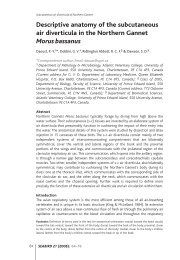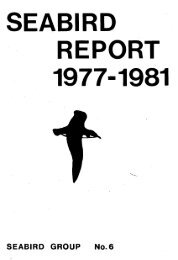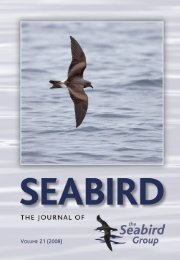You also want an ePaper? Increase the reach of your titles
YUMPU automatically turns print PDFs into web optimized ePapers that Google loves.
2001 Body mass reduction in Kittiwakes 171<br />
different from each other, but they are all significantly different from the mean<br />
values obtained during the incubation period (one-way ANOVA followed by a<br />
Student-Newmann-Keul procedure for pairwise comparisons, F4,62, P < 0.0001).<br />
Since mass-specific BMR decreases with body mass, a reduction in<br />
body mass will have an even stronger effect on the whole-body BMR. <strong>The</strong><br />
relationship between whole-body BMR and lab body mass of breeding female<br />
Black-legged Kittiwakes is described by the equation:<br />
(1) BMR = 9.1 * 10 -6 BM 2.18<br />
(least square linear regression, R = 0.80, n = 40, df = 38, P < 0.001) where BMR<br />
is in W and BM is body mass in g. Only one BMR measurement of each<br />
individual is included in the analysis, giving n = 40. Equation 1 can further be<br />
used to eliminate body mass as a determining factor and to calculate residual<br />
values of BMR<br />
(2) BMRresidual = BMRmeasured/BMRpredicted by eq. 1 * 100<br />
A regression between BMRresidual and the corresponding stage of breeding gives<br />
a significant, negative relationship:<br />
(3) BMRresidual = 104.7-0.4 * days after hatching<br />
(least square linear regression, R = -0.47, n = 40, df = 38, P = 0.002) where<br />
BMRresidual is in percent (Fig. 2).<br />
DISCUSSION<br />
<strong>The</strong> Black-legged Kittiwake has a biparental care system, both sexes taking an<br />
equal share in both the incubation period, which normally lasts for 27 days, and<br />
the chick-rearing period (Mehlum 1990). <strong>The</strong> chicks attain thermal<br />
independence about one week after hatching (Barrett 1978), but are constantly<br />
brooded for another 10 days (Gabrielsen et al. 1992). <strong>The</strong>y are dependent on<br />
food provisioning until fledging time, 5-6 weeks after hatching (Mehlum 1990).<br />
Moe et al. (2001) studied the body mass dynamics of breeding male and female<br />
Black-legged Kittiwakes in the same colony as in the present study. <strong>The</strong>ir<br />
findings showed that body mass change closely followed the changes in activity<br />
levels during different stages of the breeding cycle. During the incubation<br />
period, when activity levels are low, body mass remained stable or showed a<br />
slight increase. After hatching, the parents must provide both food and heat to<br />
their fast growing chicks and consequently less energy and time will be








